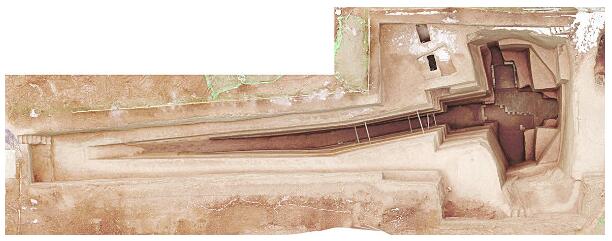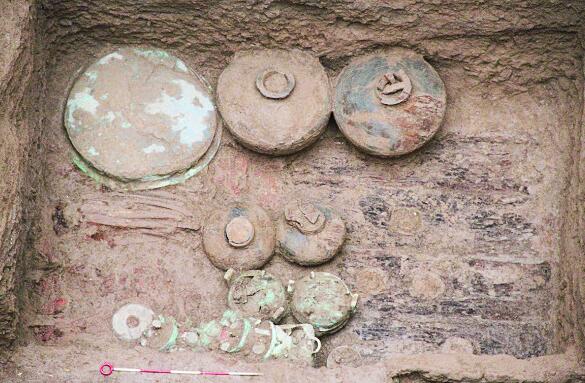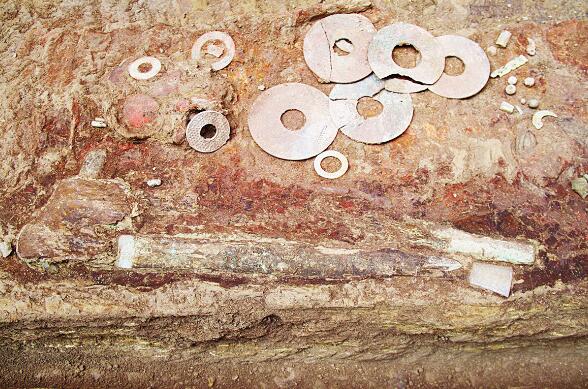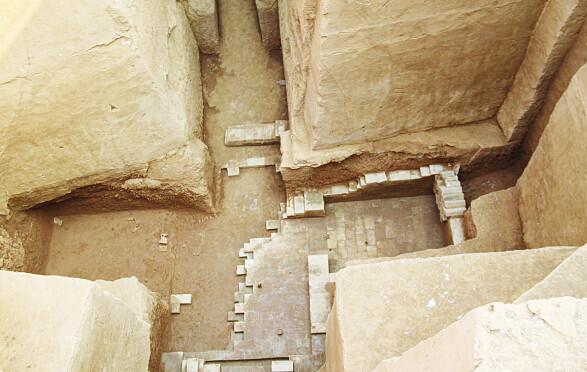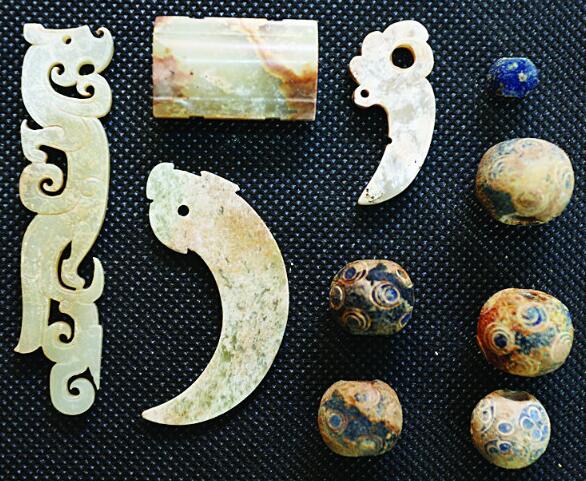Information
Tombs from Qin and Han Dynasties to Tang and Song Dynasties found in Shaanxi
From Sept 2017 to Feb 2018, Shaanxi Provincial Institute of Archaeology conducted excavation to the tombs at Qinhanxinqu of Xixian New District and Liquan County of Xianyang City in Shaanxi Province to support the infrastructure construction. Altogether 21 tombs were excavated, ranging from Qing and Han to Tang and Song Dynasties.
Qin and Han Dynasties Tombs: Altogether 9 tombs of this period were found, numbered as Poliucun M2, M3, M4, M4-3 and M7, Lingzhaocun M8, Dongdazhaicun M10, Dongshiyangmiaocun M11 and M11-1.
Poliucun M4
Poliucun M2 and M3 were both earthen shaft pit tombs, 8.5 meters away from each other south to north. M2 was rectangular in plane from east to west, 7.4 meters in length and 6.2 meters in width. The distance from top to bottom was 8.8 meters. The burial utensil was a wooden inner coffin with an outer coffin. There was a head case in the west of the outer coffin and a side case to the southwest outside the outer coffin. The tomb owner was buried upward with limbs stretched, head towards the west. There were jade discs, jade rings, jade wares, bronze swords and mirrors as burial objects found inside the inner coffin. There were also lacquer ware in the head case and bronze tripod-ding, lamp, dishes, spoons and pottery jars in the side case. Besides, many animal skeletons were found, which were estimated to be sacrificed. The tomb M3 was in the shape of “凸”. There was an accompanying earthen vertical pit to the west. The pit surface was 5.6 meters in length and 4.5 meters in width. The distance from top to bottom was 8.8 meters. To the east of the center in the bottom was a wooden box containing plenty of animal bones, seemingly skeletons of cattle, pigs and poultry. There were two outer coffins and one inner coffin in the main chamber. The coffin was located to the east of the north part of the outer coffin. The tomb owner was buried upward with limbs stretched, the head in the west and the feet in the east. The owner was initially estimated as a male around fifty. There were abundant burial objects inside the coffin and altogether 110 pieces/sets were unearthed, including jade discs, rings, pendants, seals and so on, as well as bronze swords with jade decoration, bronze buckles and silver buckles and so on. To the south-east of the outer coffin chamber was plenty of bronze ware. To the west of the coffin were two bronze mirrors inlaid with “山” pattern and plenty of lacquer accessories. M2 and M3 were similar in the tomb structure and burial objects, which were initially estimated to be in the interchange of Qin and Han Dynasties or the early Western Han Dynasty. The two tombs were located close to each other. It might be possible that the tomb owners were related to each other.
Burial gift box in Poliucun M2
M11-1 in Dongshiyangmiaocun was an earthen shaft pit tomb of early West Han Dynasty. The surface of the pit was 4.8 meters in length and 3.2-3.3 meters in width. M11 was located to the south of M11-1, with mound remained. M11 had a sloping tomb passage leading to the chamber. The surrounding walls and the bottom of the tomb were brick and the wooden outer coffin was piled next to the inside wall. The top was a dome and inside was a wooden coffin. The tomb was disrupted with only an inks-stone, 3 ironware, 6 pieces of glazed pottery, 9 bronze ware, 22 pieces/sets of jade and around 90 Wuzhu coins left. M11 was a tomb of late West Han Dynasty and the tomb owner enjoyed a higher social status.
M4 in Poliucun was an earthen shaft pit tomb with multi-brick-chambers and long sloping tomb passage. It was hard to tell the original structure of M4 with only part of the wall and the paving bricks left. M4-3 was a multi- brick-chamber tomb inside the earthen shaft pit with a long sloping passage. It broke M4. Inside the filling earth of the front, middle and back chambers were remaining of scores of pottery and a few bronze and iron wares and horse-riding figures and pottery animal figures of horses, fishes and toads. M4 belonged to the Eastern Han Dynasty and M4-3 was later than M4, which was estimated to be in the late Eastern Han Dynasty or the interchange of Wei and Jin States.
Burial jade in Poliucun M2
There are three tombs form the Late Northern-Zhou and Early Sui Dynasties numbered respectively as M1, M5 and M6. M5 was cave-chambered tomb with single chamber, double patio and long sloping tomb passage. According to the remaining red color traces, the surrounding walls were painted with screen-like frames and simple figures or imitating wooden structures. Pottery made up the most of the burial objects, including 6 pottery bowls, 1 bottle, 1 jars, 1 round tile, 1 hairpin and 1 Wuzhu coin. M6 was cave-chambered tomb with single chamber, one patio and long sloping tomb passage, in the shape of “甲”. The corners of the four walls were originally painted with red frames. To the north of the chamber was a raw-soil coffin bed. The south front and four centimeters to the front end of the coffin bed were painted with lime coating and red color. The burial objects were mainly pottery, including 5 pottery bowls, 2 dish pots, 1 pottery amphora, 1 set (piece) bronze belt, 1 seashell and 1 ironware. Judging from the tomb structure and style of objects, M5 and M6 were tombs of Late Northern Zhou and Early Sui Dynasty.
Tomb chamber in Poliucun M4-3
Tang Dynasty Tombs
The 4 Tang Dynasty tombs found were all cave-chambered tomb with single chamber, in the shape of “刀” and the chambers were located to the west of the tomb passage. They were numbered as Poliucun M4-2, Lingzhaocun M9-1, M9-2 and Dahancun M3. There were only a few burial objects unearthed, including tower-like jars, Kaiyuan Tongbao coins and so on.
Song Dynasty Tombs: Altogether five Song Dynasty tombs of similar structure and scale were found and numbered respectively as Poliucun M4-1, Lingzhaocun M8-1, Dahancun M1, M2 and M4. Only the chamber of Lingzhaocun M4-1 was cleared, and there were three owners buried separately in three coffins with plate tiles under their heads. Dahancun M1 and M2 were joint couple buried separately and no burial objects were found. There were five bodies inside Poliucun M4-1 and Dahancun M4 was a single tomb with a delicate five-foot green glaze porcelain furnace unearthed, which was from Yaozhou kiln of Song Dynasty.
Jade artifacts
Altogether 21 tombs were found this time, and 350 pieces (sets) of cultural relics were unearthed, including pottery, porcelain, bronze ware, jade and ironware. Poliucun M2 and M3 were well preserved and un-looted. The unearthed burial objects were the most exquisite and rarest. Poliucun M4 had a curving passage, which was unusual in tomb structure. The chamber of M4-3 was adapted from that of M4, which was rare in former finds. And its burial objects were also hardly seen in Central China. Poliucun M5 and M6 were in late Northern Zhou and early Sui Dynasties. The bottom of the south and north wall of the patio was battered severely. The tomb structure bore strong characters and some murals were left, enriching the burial archaeological data of the same time. The four Tang dynasty tombs belonged to the late of the prime period and middle and late of Tang Dynasty. Tower-like jars were the major burial objects, and the tomb structures were mainly cave-chambered tombs in the shape of straight or arc “刀”. Poliucun M4-2 was a group burial tomb with five bodies in one coffin, two males and two females lying to the east and west and one child crouching at the foot. It was strange burial custom and traces of second-times burial were found. The archaeological excavation of Yinxi Railway project in Shaanxi has made significant findings, and the data is now under further collection. (Translator: Yuan Yuan)
Category: English
News
Information
Key words:

